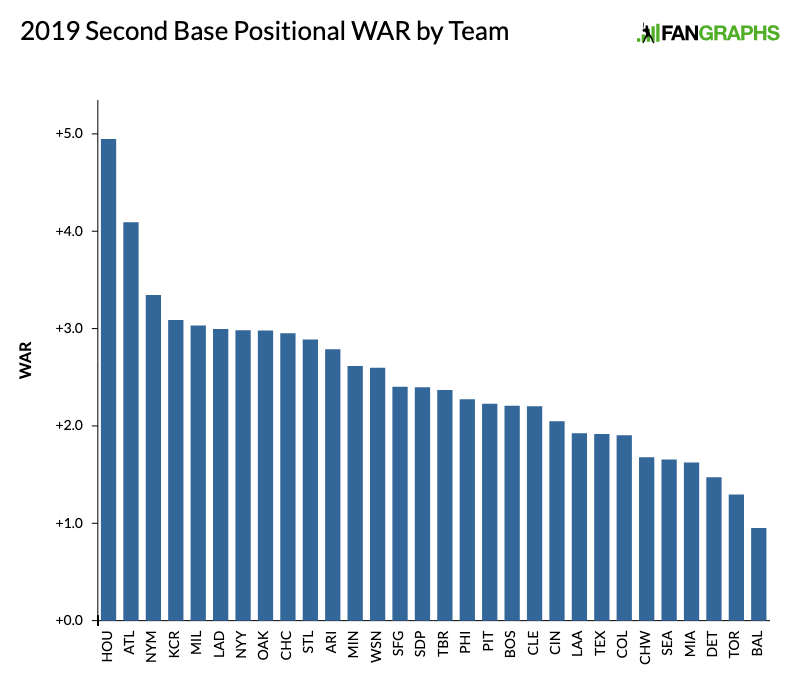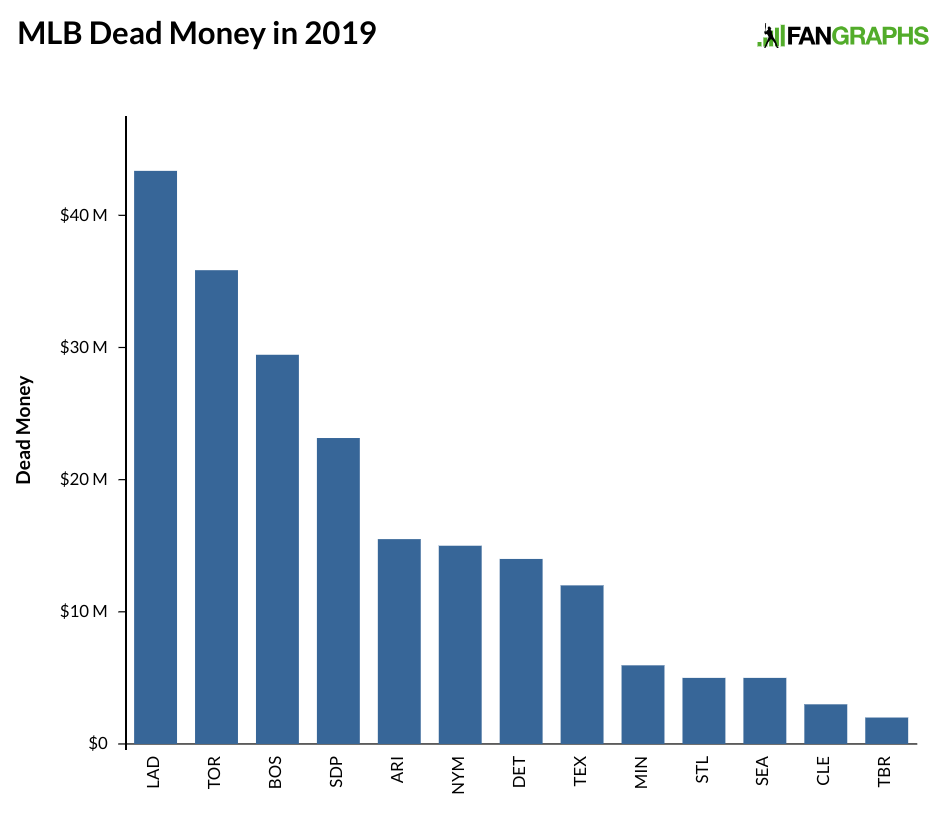Mike Trout Leaves Money On the Table Again
Mike Trout is a better player than Bryce Harper and Manny Machado combined. He’s been more than twice as valuable as each of those players in their young careers. And yet Mike Trout is about to agree to a contract that, per ESPN’s Jeff Passan, will pay him like he’s one of the greatest players of this generation instead of potentially being the greatest player of this century, and one of the greatest baseball talents of all time. As first reported by Passan, Mike Trout and the Angels have agreed to a 12-year deal worth $430 million, with Bill Shaikan reporting the deal will come in at $426.5 million. Because Trout was already owed $66.5 million over the next two seasons, the contract is functionally a 10-year extension worth $360 million. Trout is essentially accepting something similar to the Harper/Machado deals two years in advance. This is not the first time Trout has made this choice, which is very much a personal decision, but it is one that has cost him potentially hundreds of millions of dollars.
In 2014, Trout was coming off an eight-win season, which itself came on the heels of two 10-win campaigns. His 29.2 WAR mark through his age-22 season was the best in baseball history. Before he signed a six-year, $144.5 million contract giving away three free agent seasons, Dave Cameron wrote about the potential for a contract extension, and expected a figure more than $100 million higher. When Trout actually signed, Cameron followed up:
You don’t need another 1,500 word explanation of why this is a hilarious steal for the Angels. Trout would have made something like $50 to $60 million in arbitration had he gone year to year, so the Angels are basically getting three free agent years for $85 to $95 million. This doesn’t come anywhere near Trout’s value, and Trout has left an enormous amount of money on the table. Even if his goal was to reach free agency again and sign a second monstrous contract, he still is worth so far more than the roughly $30 million per year he signed away three free agent years for.
That bargain five years ago made the current one possible. Because Trout had two more years left until free agency (instead of entering the market last offseason), he was limited to the Angels when it came to contract partners. Because the Angels’ risk of losing Trout wasn’t going to present itself for another two seasons, any new contract with him was going to come with a discount. In this case, the discount meant signing a deal like Harper and Machado’s instead of one like Alex Rodriguez’s.
After Harper and Machado signed their contracts, I attempted to compare the two deals because it can be difficult to put a 13-year deal and a 10-year deal for differing amounts into proper context. The present-day values of each contract is below, with the numbers translated into a 10-year deal, and Trout’s contract listed with just the extension (2021-2030), as well as with the two years Trout was already guaranteed (2019-2030). The numbers have been updated now that we know Trout is paid $36 million the next two seasons and $35.45 million each year beginning in 2021.
| Total Value | Present-Day Value | 10-Year Equivalent | |
|---|---|---|---|
| Bryce Harper | $330 M | $220.8 M | $305 M |
| Manny Machado | $300 M | $217.4 M | $300 M |
| Mike Trout (2021-2030) | $360 M | $225.5 M | $311 M |
| Mike Trout (2019-2030) | $426.5 M | $289.6 M | $400 M |
The Angels appear to have looked at Mike Trout and said, “We know we owe you about $65 million over the next few seasons. Keep that and we will give you the Harper/Machado contract right now.” Trout said yes, and now the Angels have one the best players in baseball history locked in for his age-29 through age-38 seasons. Even when you factor in the two years Trout is already owed, that $400 million is significantly below his value, assuming that Machado and Harper are worth $300 million. Those two years left until free agency meant a massive discount for the Angels.
When we call this deal a bargain, we can look at Mike Trout’s contract relative to Harper and Machado’s, and know that Trout is only receiving a little more money despite being a lot better. We can also look at potential future value. I love to look at comps and try to get a sense of a player’s future, but comps aren’t really fair for Mike Trout because there are barely a handful of players who even come close to his level of play. Consider Trout’s career trajectory by year, and the number of players ahead of him by WAR.
Ty Cobb the only comp for Mike Trout. Ty Cobb! Trout ranks third right now through age-27 even though he hasn’t even played the season yet, and he needs just four wins to pass Cobb and Mickey Mantle. He’s already surpassed the average Hall of Famer. Maybe you think that the early start to Trout’s career inflates the numbers. Even taking away his first two seasons, from age-22 through age-26, the only players with more WAR are Mantle and Cobb. Even just looking at the last three years, which includes an injury-shortened 2017 campaign, only Babe Ruth, Mantle, Rogers Hornsby, Jimmie Foxx, Lou Gehrig, Tris Speaker, Alex Rodriguez, and Cobb are ahead of Trout. If Trout plays like any of those players, he’ll cost something like $4 million to $5 million per win over the last 10 years of the deal. If we wanted to conservatively estimate the current value of a win on the free agent market at $9 million without any inflation, Trout wouldn’t need to age like one of the 10-best players in history — aging like the 50th would still be a good value.
The deal is such a slam dunk for the Angels that it feels a little silly to talk about what it means in baseball terms. The Angels get to keep one of the best players in history. They can now plan for the future knowing they have Trout. It would have been fun to see what an all-in Angels team would’ve looked like in 2020 with Trout a pending free agent, but hopefully this deal means we get to see the fun of a franchise that is secure in its star ensuring that that star gets a ring. After all, Mike Trout in the playoffs is good for baseball.
When it comes to adjusting the biggest contracts in baseball history for inflation, this one is a little tough to assess. We have that $430 million, but we also have that $363.5 million that doesn’t kick in until 2021. To provide some historical context — as I did for Machado and Harper earlier this offseason and later updated — I’ve included two Trout contracts below. The first is the $426.5 million figure representing the total value of the money owed to Trout; the second is Trout’s extension, assuming 5% inflation in the following two seasons.
| Player | Year | Years | Total Value ($/M) | 2019 Adjustment ($/M) | AAV 2019 ADJ ($/M) |
|---|---|---|---|---|---|
| Alex Rodriguez | 2001 | 10 | $252 M | $592 M | $59.2 M |
| Alex Rodriguez | 2008 | 10 | $275 M | $448 M | $44.8 M |
| Derek Jeter | 2001 | 10 | $189 M | $444 M | $44.4 M |
| Mike Trout | 2019 | 12 | $426.5 M | $426.5 M | $35.5 M |
| Giancarlo Stanton | 2015 | 13 | $325 M | $393 M | $30.3 M |
| Manny Ramirez | 2001 | 8 | $160 M | $376 M | $47 M |
| Albert Pujols | 2012 | 10 | $240 M | $358 M | $35.8 M |
| Bryce Harper | 2019 | 13 | $330 M | $330 M | $25.4 M |
| Ken Griffey, Jr. | 2000 | 9 | $116.5 M | $330 M | $36.6 M |
| Mike Trout (extension only) | 2021 | 10 | $360 M | $327 M | $32.7 M |
| Prince Fielder | 2012 | 9 | $214 M | $319 M | $35.4 M |
| Robinson Cano | 2014 | 10 | $240 M | $310 M | $31 M |
| Manny Machado | 2019 | 10 | $300 M | $300 M | $30 M |
| Kevin Brown | 1999 | 7 | $105 M | $297 M | $42.5 M |
| Joey Votto | 2014 | 10 | $225 M | $290 M | $29 M |
| Mark Teixeira | 2009 | 8 | $180 M | $290 M | $36.2 M |
| Joe Mauer | 2011 | 8 | $184 M | $289 M | $36.1 M |
| Mike Hampton | 2001 | 8 | $121 M | $284 M | $35.5 M |
| Clayton Kershaw | 2014 | 7 | $215 M | $277 M | $39.6 M |
| Todd Helton | 2003 | 9 | $141.5 M | $277 M | $30.8 M |
| Jason Giambi | 2002 | 7 | $120 M | $276 M | $39.4 M |
| Carlos Beltran | 2005 | 7 | $119 M | $263 M | $37.6 M |
| Nolan Arenado | 2019 | 8 | $260 M | $260 M | $32.5 M |
When stacked up against comparable players and comparable contracts, Mike Trout was a humongous bargain in his last contract and will be one in his the next, but if we can play devil’s advocate a little, it’s tougher to determine how much Trout actually cost himself. Let’s say he had been a free agent last offseason like he would have without a contract extension. What would his contract have been? There’s a reasonable argument for 15 years and $600 million. Look at the Alex Rodriguez contract above. In another two years, might $500 million been on the table? That might have been what Trout was looking at, but what if last year the market didn’t quite develop as he had hoped, and he ended up with just $500 million? What if the top offer had only been $400 million after 2020? Does that seem so far-fetched given the way these past two offseasons have progressed?
Trout is now set to make around $460 million for the remainder of his free agent years. He jumped the gun twice and took a discount. The value he will provide will far exceed the money he is set to earn. It’s possible, however, because of the way spending has progressed, that Trout has actually cost himself little to no money by signing these extensions. Mike Trout was always going to be a bargain; we have a hard time wrapping our heads around the number he’s really worth. He’s the best player in baseball, and simultaneously the most underrated one. That’s a ridiculous feat, but with Mike Trout, we’ve grown accustomed to ridiculous feats.


